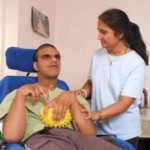
The recent publication of Raising Our Sights, the DH report into support for people with profound intellectual and multiple disabilities set out a challenge for everyone concerned with understanding and responding to people with such disabilities.
A number of projects have produced practical guides for involving and engaging with people, for example, Mencap’s Involve Me guides.
On a day to day basis, those supporting with profound learning disabilities who do not use words to communicate, struggle to ensure that they are interpreting non-verbal communication correctly. One of the strands of research that is supporting this work looks at ways in which physiological changes might be used to validate the interpretations of non-verbal expressions of mood or emotion.
The researchers in this small study set out to explore how well behavioural observations used to judge emotional states of people with profound learning disabilities could be validated by physiological changes. They wanted to see if such observations could be validated using respiration (rib cage contribution, total breath duration, inspiratory time, expiratory time, tidal volume, mean inspiratory flow, minute ventilation) and heart rate variability.
What they did was present a range of negative and positive stimuli to twenty-seven people with profound learning disabilities. During the process, they measured respiration and heart rate variability. Each person’s behaviour during the presentation of the stimuli was coded as emotive or not.
What they found was that there was a higher percentage of rib cage contribution, marginal lower mean inspiratory flow and lower heart rate variability when the expressed emotions became more positive.
They conclude that their findings add to the evidence of the validity of the use of behavioural observations to make enable inferences to be made about the emotional states of people with profound learning disabilities.
See me, feel me. Using physiology to validate behavioural observations of emotions of people with severe or profound intellectual disability, Vos P et al., in, Journal of Intellectual Disability Research, 57: 452–461

“@WELDBlog: Measuring physiological changes can help validate emotional states of people with profo.. http://t.co/vrOiPeEHEA @ldnursingshaw